An engagement model represents an approach that implies engaging and building partnerships between the software development company and its clients. Why is it important after all?
In the remote work era, efficient collaboration became a vital aspect of literally any industry. However, in IT, this aspect is a primary key to success. While the IT market grows and prospers, the level of responsibility rises exponentially. Accordingly, managing today’s leading companies requires a thoughtful approach and solid expertise. Luckily, there’s a way to simplify this process.
In this piece, we will figure out what is an engagement model. Consequently, we will also cover essential engagement models in IT. You may wonder why you need them beforehand. The point is that in modern businesses, all processes must operate like clockwork. Otherwise, weak parts can become a sore that will affect the business. Needless to mention lesions they may cause.
Apart from listing engagement models, we will get into more detail, revealing their advantages and in which cases they suit the most. Let’s move on!
Engagement model definition
At its core, the IT engagement model is a methodology or a set of guidelines. It defines the business relationship between the client and the development team. Besides, it is also applicable to relations between a company and stakeholders or company-users relations.
Normally, each engagement model we will walk through has a set of predefined rules to ensure cooperation effectiveness. Hence, these regulations include rules, commitments, obligations, and responsibilities both sides must adhere to. Lastly, all key points are usually listed in a legally binding contract both parties sign.
Types of engagement models
There are many different engagement models in IT. Notably, choosing a business engagement model depends on the project requirements, budget, and organizational structure. It's essential to select the right model to ensure successful project delivery and your satisfaction. In this article, we will walk through four essential ones: extended, dedicated, fixed price, and time and material models.
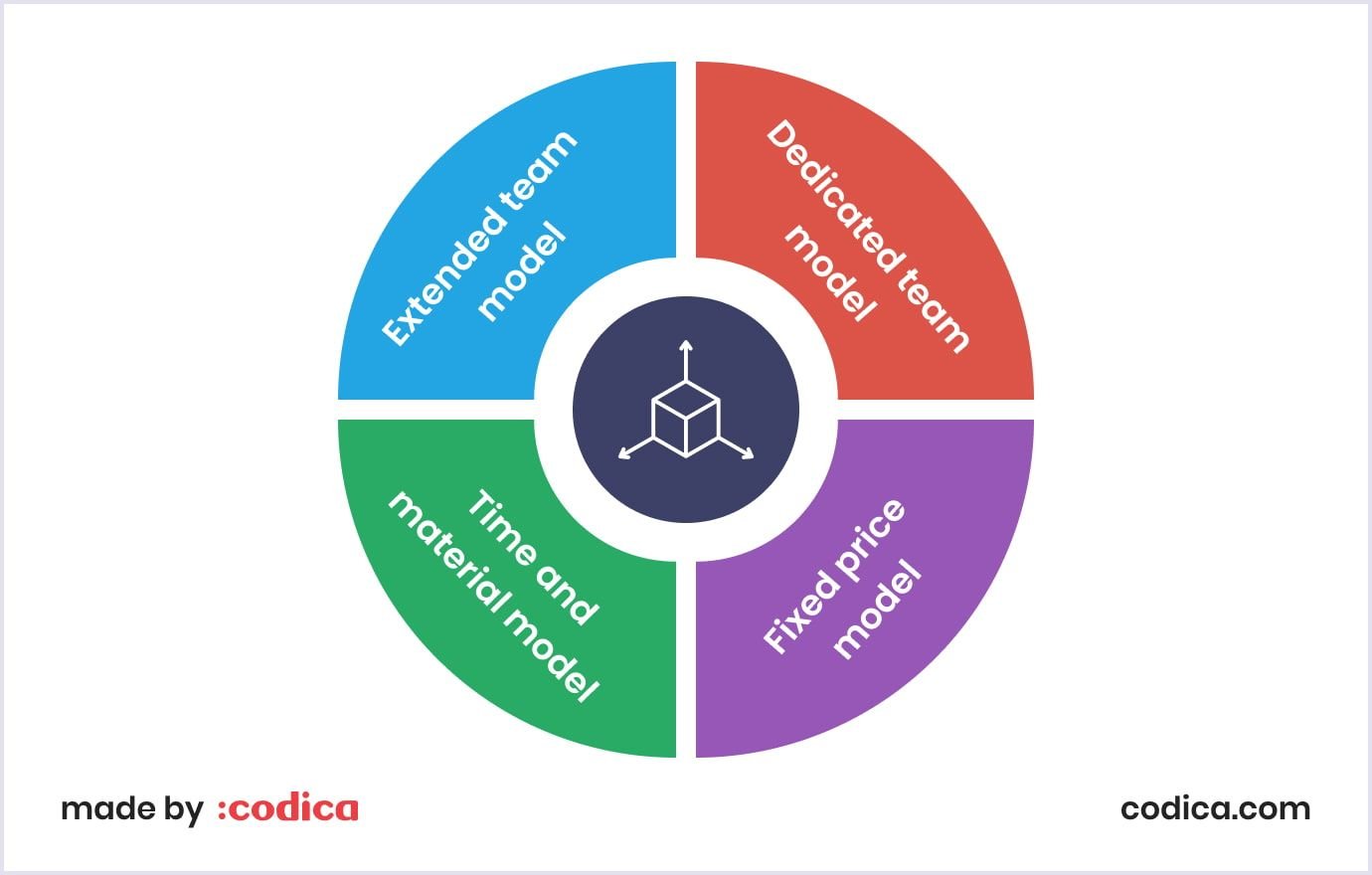
Speaking objectively, there’s no best model, but there’s the flexibility of choice. Each of them can be adjusted to fit your needs, especially in the fast-changing environment. Hopefully, a detailed overview of the IT engagement model examples will help you to make a moderate choice. Without further do, let’s discover them with their respective pros and cons.
Read also: Top 11 Effective Partner Engagement Strategies for Business Owners
Extended team model (ETM)
As the name suggests, ETM implies hiring additional specialists to complement the in-house team.It is worth noting that those members who extend the team usually work remotely and are hired for a single project exclusively.
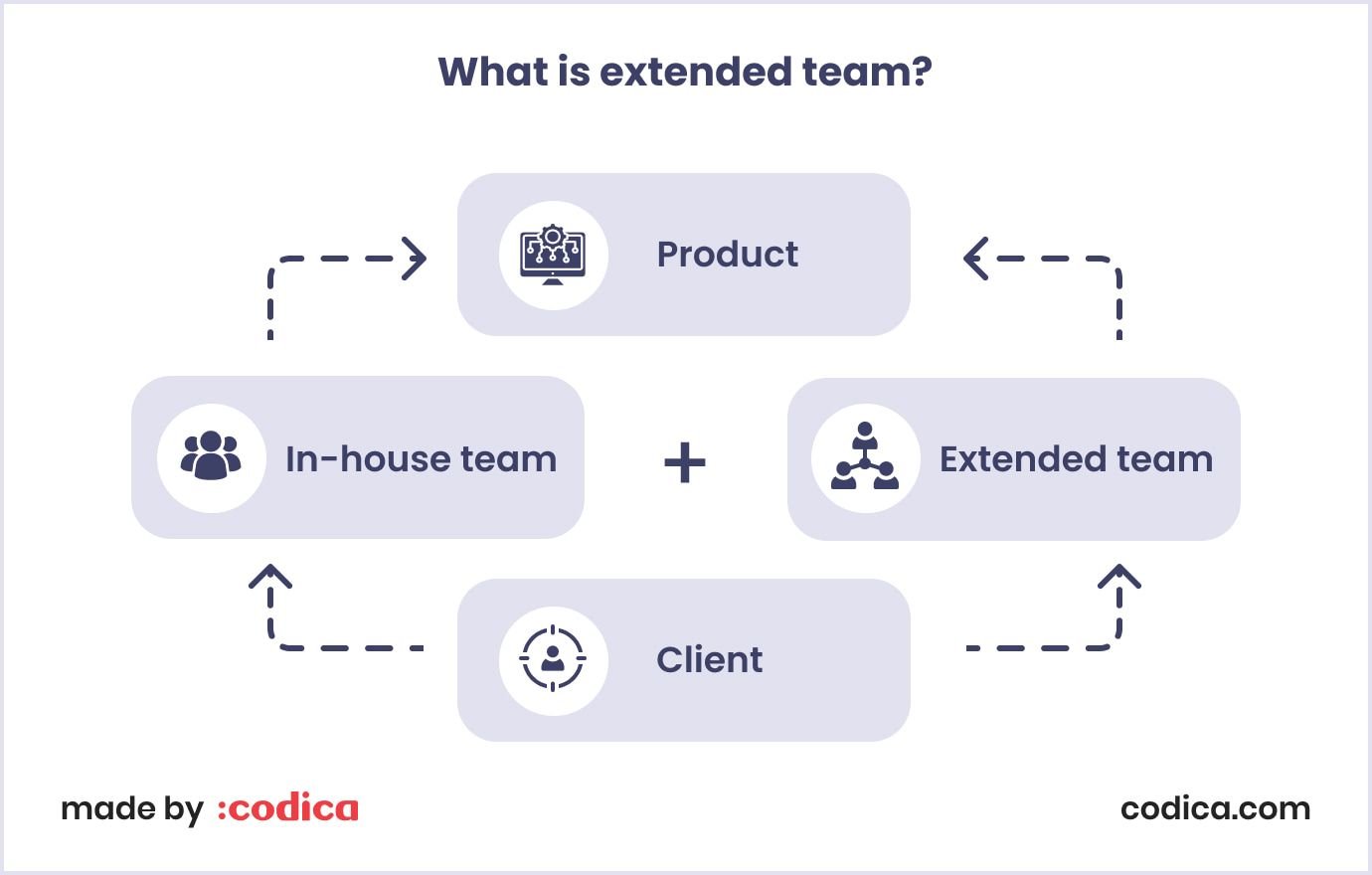
The extended team can consist of various specialists depending on the needs during the development. For instance, some of the in-demand roles are software engineers, QA specialists, and project managers. The extended team model has several advantages. Let’s list them next.
Advantages of the fixed price model
Access to a broader talent pool
Depending on the task specifics, the company can broaden the team by hiring narrow-niche specialists to deliver the best quality product. Needless to say, it is simply cheaper compared to delegating additional tasks to in-house specialists.
Financial benefits
ETM implies that a company can hire people only for the project duration and build an outstanding product with their help. It may take more time to establish a good internal connection, but the financial aspect of this model is quite profitable. Paying people that do a certain job in a limited time frame saves costs in the long run. Moreover, such an approach allows for building a very effective environment.
Flexibility and scalability
This widely popular model allows companies to scale the team up or down depending on project requirements. It also enables the possibility of leveraging the expertise of the extended team to meet the project goals according to the budget or deadlines.
When to choose?
An extended team model is a fitting choice in various situations. One of them is when certain specialists are needed on a particular project without implementing changes in the in-house team structure.
For example, if the project is oriented on something very specific, the team might need an expert in that field to make the product natural and user-oriented. Another fitting example is when the product heavily relies on a certain technology (i.e., blockchain). In this scenario, you may need more hands to smooth the corners and hone the project to perfection.
The extended team model is also a good fit when there’s a new branch of product growth. For instance, the extended team can be hired to develop a new product branch while the in-house team is busy maintaining the main one.
Dedicated team model (DTM)
This model type is somehow similar to the ETM but with one significant difference. It has more focus on the proper assignation of resources. At its core, it implies a dedicated professional team to be formed and assigned to work on a specific task or project.

Normally, DTM is adopted in an agreement between the client and the service provider. In this matter, the service provider is obliged to provide the client with skilled developers, designers, or DevOps specialists on a long-term basis. Within the framework of this model, the dedicated team works exclusively on the given project with a set budget and deadlines.

Advantages of the dedicated team model
Flexibility
The DTM model is very flexible, and the hired team can be adjusted or expanded to meet changing production needs. Also, the model implies that the team has to be highly responsive to the client’s needs and open to cooperation. As a result, such an approach allows for quickly adapting to changes within the project.
High-level of control
With an exclusively project-oriented team, the clients often can manage, supervise or spectate the team’s work. Moreover, DTM provides a more personalized and collaborative approach to project management which ensures that the team works closely with the client. As a result, the approach is beneficial because both parties can be sure their expectations and requirements are met.
Numerous firms to contract worldwide
DTM is a highly profitable choice for companies without in-house development teams. Instead, they rely on cooperation with other agencies. Consequently, the software development market is gigantic, making it easy to find a reliable team with relevant experience that matches the company’s needs.
Cost efficiency
DTM brings a huge advantage of managing the budget while allowing companies to remain flexible. Delegating your outsource task to the dedicated team can save a huge part of the development budget. DTM allows to compose very precise budget estimates because the total cost is derived from each specialist’s salary.
When to choose?
As we can see, a dedicated team model is the best choice when a technically difficult product requires expertise and skills. Also, a DTM is a popular choice in companies that don’t have an in-house development team.
Another scenario where it’s the best-fit model is when you’re only concerned about monitoring the execution without worrying about anything else. Hence, choosing the most professional team for this matter is the best approach.
Fixed price model
This business engagement model type is all about planning. Being the most common on the market, it implies a thorough planning process that determines essential points in the project lifecycle. Typically, the project’s budget, deadlines, and team composition are predetermined to ensure a transparent and reliable development process.
Notably, this model is called different names, including ‘fixed-time/scope/cost/bid.’ Development-wise, it implies meticulous documentation of all requirements and a development roadmap. Moreover, companies often decompose development into well-thought-out milestones with strict deadlines.
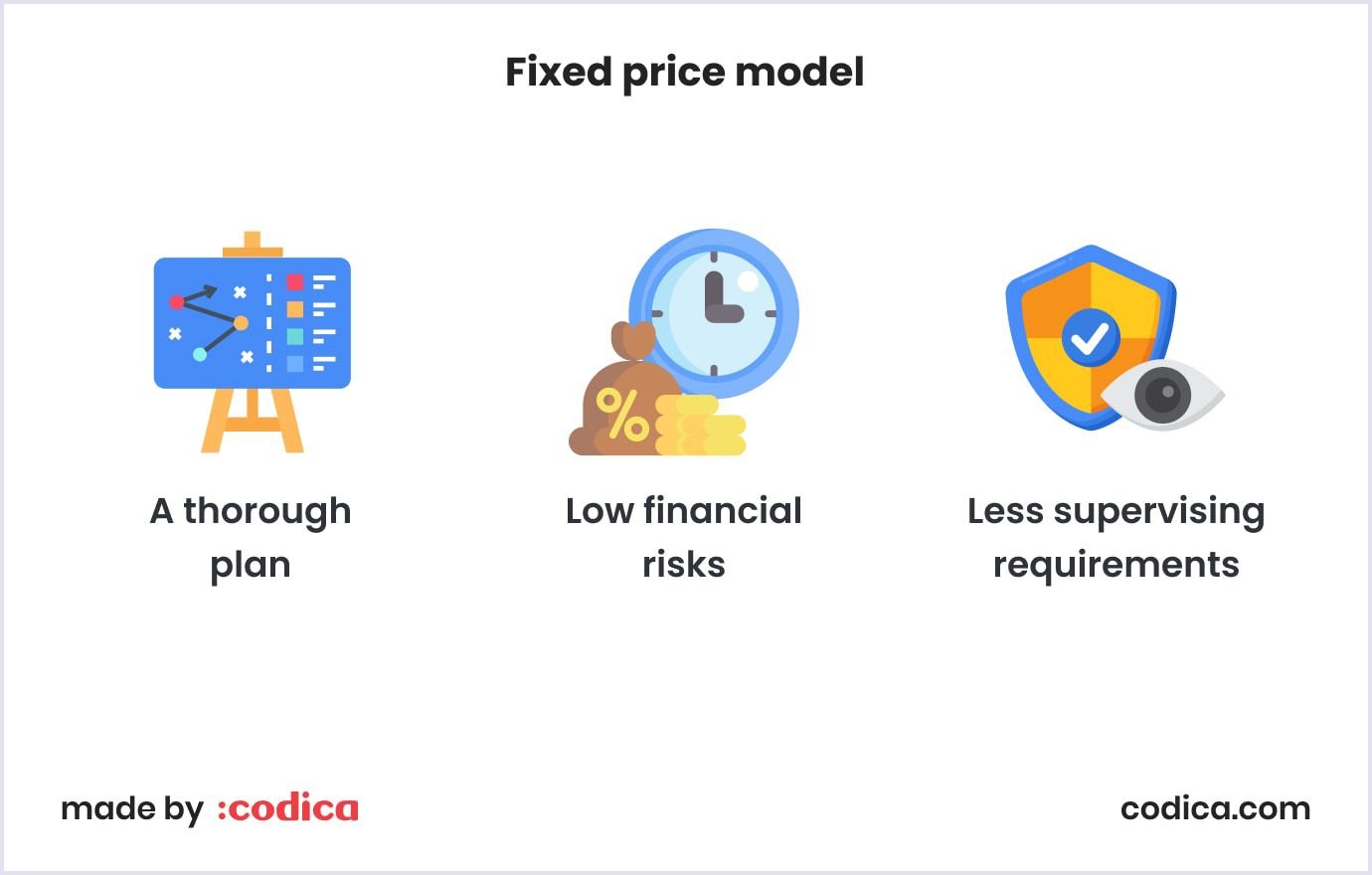
Predictability is one of the main reasons why the fixed price model is popular. Clients requiring development services are often pleased to have a transparent expenses list and the time required. Nonetheless, this approach can be challenging for the vendor, as they may have to absorb additional costs or delays that arise during the project.
Advantages of the fixed price model
A thorough plan
Working on today’s edge-cutting products requires a lot of planning which this model brings more than enough. That being said, having a detailed roadmap before the development is even started is a huge advantage. It is also beneficial in making sure that the whole process grows predictably and without delays.
Low financial risks
Applying this model means that the project's financial aspect is also predetermined. Consequently, thanks to the thorough plan we discussed, extremely low financial risks become a huge advantage. Nonetheless, they might still have a place, but this scenario is rather rare and may only occur because of unpredictable circumstances.
Less supervising requirements
With a fixed price model, when the development starts, the whole team knows the requirements. In other words, the process is predetermined and, thus, predictable. Consequently, the project manager's job may switch from delegating the project’s growth to simply supervising. Thus, project managers must ensure everything goes according to the plan and within the timeline.
When to choose?
The fixed price model can be commonly met in small indie companies. It is suitable for relatively small projects with a well-defined scope of work and clearly outlined requirements.
It may also be a good choice when the target project requires a limited amount of improvements. Thus, with a great plan, a fixed-price model can do wonders in delivering a perfect quality product per all requirements.
Time and material model (T&M)
This model represents a pricing strategy where a project is billed according to the time and resources spent during the development. Often, this model is used when the objectives are uncertain or likely to change in the foreseeable future. At Codica, T&M is our primary cooperation model, as it’s extremely flexible and allows us to deploy the working process very fast.
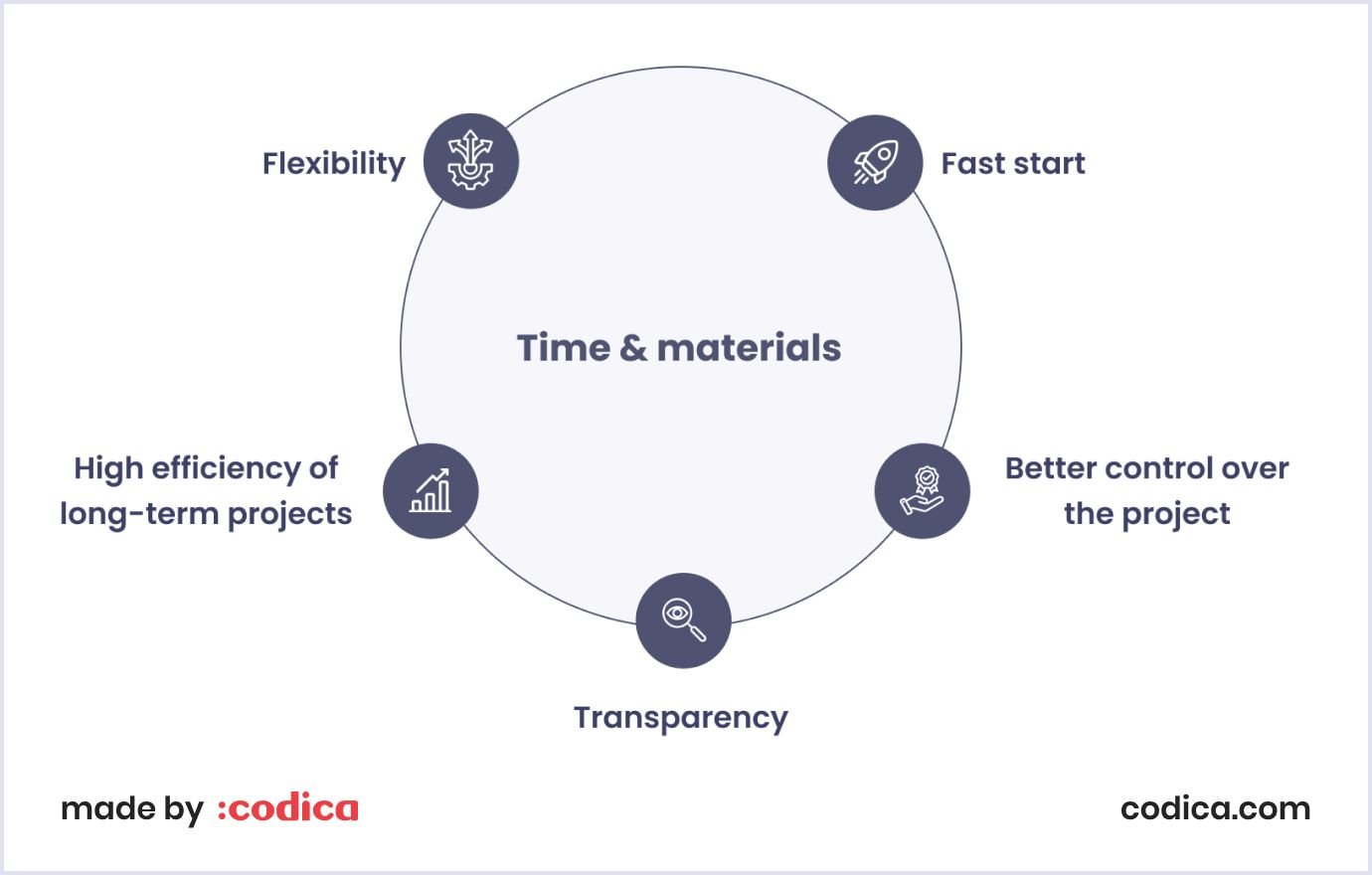
Compared to the fixed price model, in T&M, you pay for the actual results and accomplished tasks instead of investing in the plan that will be built in the future. This model is adjustable to meet ever-changing needs in the fast-paced business environment.
Advantages of the time and material model
Flexibility
Given that the T&M model implies charging the client for the actual accomplished work, this approach is highly flexible. For instance, some improvements and ideas may arise during the development. Unlike in the fixed price model, those ideas can be implemented in the process right away. Despite all the risks, it is still an advantage that may bring newness to the product.
Fast start
Product development always starts with planning. But with a time and material engagement approach, planning takes way less time and can even get upgraded along the way. Hence, projects tend to start extremely fast.
When to choose?
Summing up the above, the time and material model is the best choice in three scenarios. Firstly, it suits projects with unclear scope. If the scope is uncertain and may undergo changes, it would be silly to charge developers for a specific time period. Instead, T&M allows you to charge people based on the actual progress and time spent.
Secondly, T&M is an excellent option for ongoing projects. Situations, where companies underestimate the difficulty are not unheard of. Consequently, they need to hire more people to take part in the job.
Finally, well-researched complex projects also work great with time and material model. If the project requires deep market research or thorough product discovery, estimating the hours and needed resources beforehand becomes hard.
Engagement model we use at Codica
At our company, we also adhere to the time and material model as we find it the most comfortable cooperation approach. According to the model we establish with the client, we decompose our work into milestones for maximum convenience.
According to the T&M best practices, we report time spent on the development each week via detailed weekly reports. Moreover, we developed our own workday time tracking bot. It provides transparency in our work, allowing project managers to download auto-generated reports and timesheets.
Next on, at the beginning of each month, we compose an invoice based on the resources we spent. What’s more beneficial, we compose the best and the worst case scenarios during the product discovery. They allow us to provide the most precise estimates before the development even starts and follow them during the entire process.
Let’s switch to examples, shall we? When we worked on Tradeaboat – a marketplace for boats - we took advantage of T&M, resulting in long-lasting cooperation with Celso Prado, our beloved client.
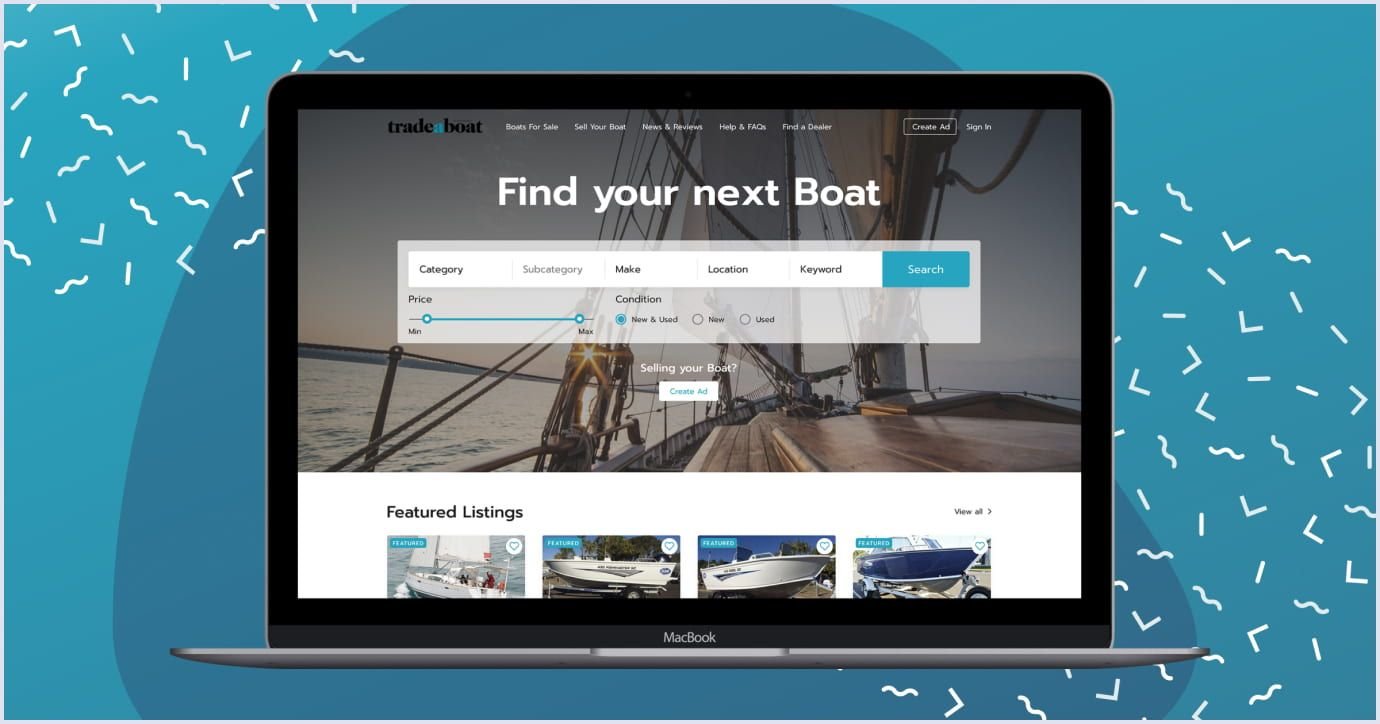
Needless to say, our cooperation was extremely fruitful. We built a competitive marketplace platform thanks to the engagement model we chose and the partnership we established. As a result, Tradeaboat features highly optimized performance on both mobile and desktop platforms, enhanced UI/UX design, and best content monetization practices.
How to select the right engagement model?
When it comes to selecting the partnership engagement model that will complement your business needs, there are various aspects to be aware of. At this point, it’s crucial to realize how important this choice is. Generally, all aspects matter as the final choice is a combination of smaller aspects. They, when put together, unite in a bigger picture, highly affecting your business’s performance. Next, let’s determine the best choice based on certain criteria.
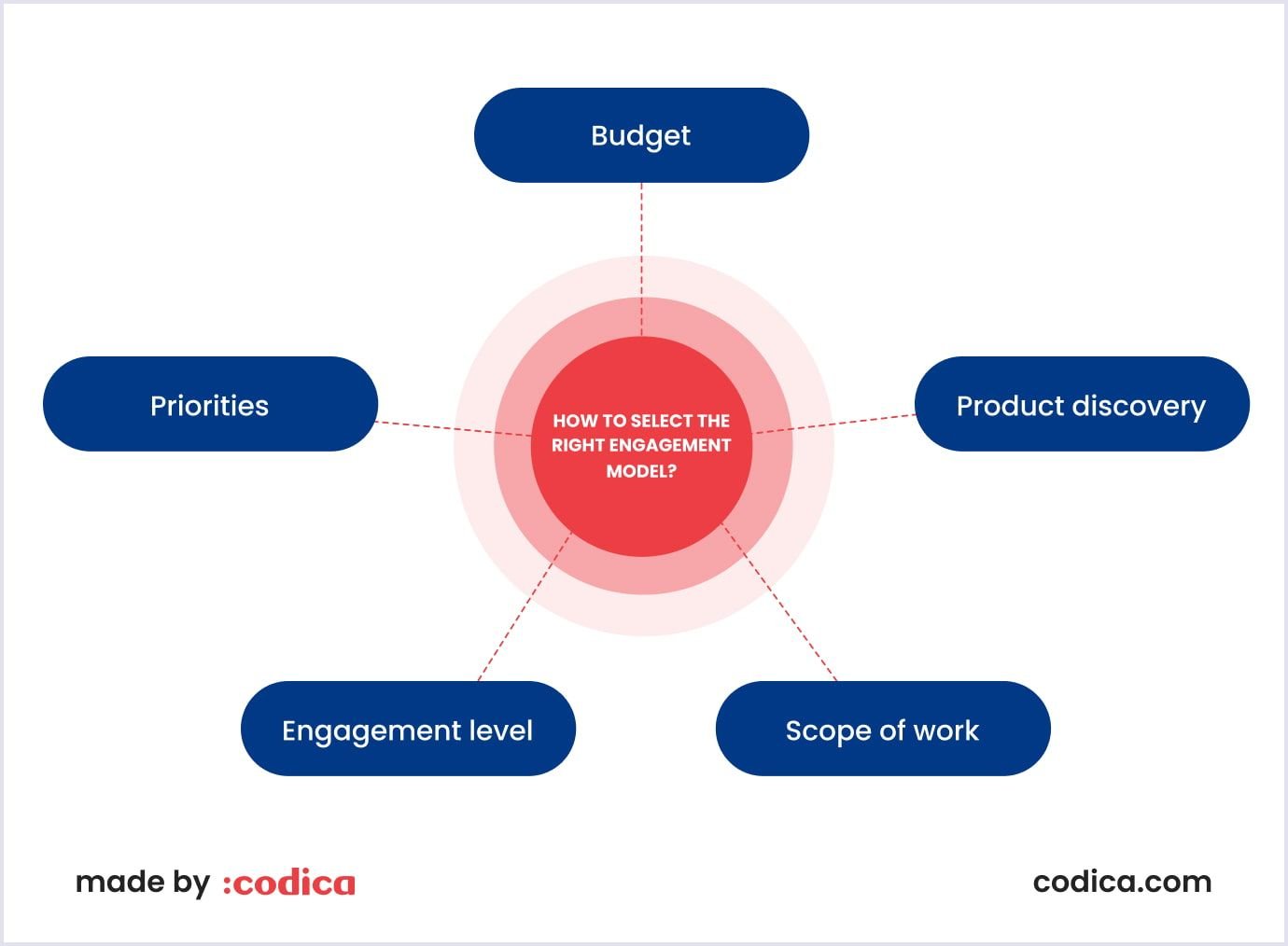
Size of the team
This aspect is crucial when making a choice. Let’s make it simple. If your in-house team is comparatively small and you have strict deadlines and a limited budget, the fixed-price model will be a great choice. As a result, this model will allow you to distribute resources wisely, focusing on composing a plan and simply adhering to it throughout the whole development.
On the other hand, if you have a bigger team and can afford some flexibility, the T&M model would be in favor. Hence, it will allow you to manage resources wisely and make a more open-minded development environment.
Budget
The financial aspect can strongly affect the right business engagement model choice. For example, if a budget is comparatively small and you are limited in time, the fixed price model will suit the most.
Alternatively, if budget is not an issue and you need more control over the resources used, time and material would be a fitting choice. Lastly, a dedicated team model is an excellent choice for planning a complex long-term project. Budget-wise, the dedicated team model is highly beneficial because it’s cost-effective. In other words, it offers an appealing price-value rate.
Product discovery
At Codica, we provide product discovery by conducting deep research on your future brand, revealing potential rivals, and evaluating your product growth. It is a process at the initial point of successful product development. Hence, it allows you to minimize risks, save costs and make more balanced decisions. Here’s a video that shows how it works in more detail.
So, based on the product discovery process, the project requirements may change over the course of development. This is likely to happen because the digital world quickly adapts to the ever-changing needs of users. Hence, applying a time and material model to your business would be a winning approach.
T&M gives plenty of room for flexibility and quick change adaptation. Moreover, it’s compatible with the agile approach we adhere to. Adopting this methodology allows for dividing the work into sprints (short tasks) and continuously improving the product.
Scope of work
In this matter, the scope of work refers to how the amount of work is defined. Accordingly, a project with well-defined objectives and a clear roadmap will likely benefit from the fixed price model.
However, with regularly evolving requirements in big projects, you’d better stick to the time and material model. It will be more effective given that many variables change in most modern development processes, and teams must adapt quickly to new realities.
Engagement level
The right communication and engagement level in the team matters a lot. Consequently, a dedicated model is a good choice if you seek a high level of engagement and collaboration with your team. Alternatively, both T&M and fixed-price models would be a better choice if you prefer a more hands-off approach.
Priorities
In terms of choosing the right engagement model for software development, your priority is the most obvious factor influencing the decision. That’s why the actual choice is pretty straightforward.
For example, the fixed price model is an obvious choice if the main priority is to complete the project no matter what. A strict timeline and painstakingly calculated budget strongly influence this choice.
On the other hand, companies always need to control their resources and the number of developers allocated to the project. Such teams usually have flexibility with requirements. Thus, the time and material model is their best fit.
If a product needs a lot of effort and dedication put to its final quality, a dedicated model will fit just fine. This scenario likely occurs when the product is exceptionally significant, has a lot of investment, or is technically difficult.
Conclusion
Choosing the right IT engagement model is crucial for businesses to achieve their desired outcomes while optimizing costs. The four types of engagement models in IT we listed have distinct advantages and disadvantages depending on the business's needs, budget, and timeline.
Ultimately, by selecting the right IT engagement model, businesses can stay competitive, innovate, grow, and meet their goals. At Codica, we have the expertise to consult our clients on various aspects of their requests, including the software development engagement model choice. Hence, all works in our portfolio wouldn’t exist if we didn’t establish the right engagement model with our clients.
We are always glad to have new opportunities to work on exciting projects. If you have an idea that can fire – feel free to contact us!
